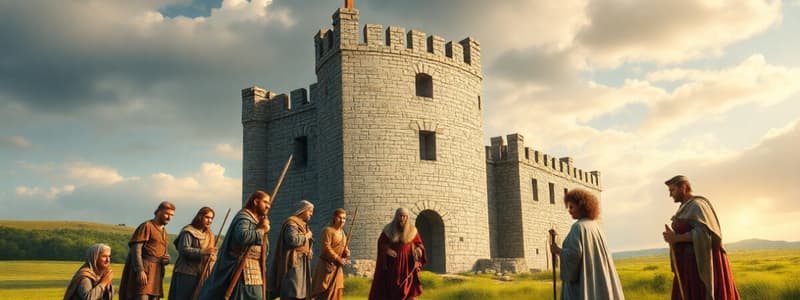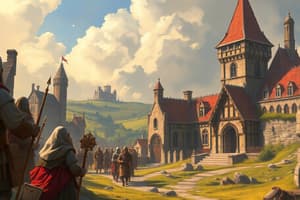Podcast
Questions and Answers
Who was possibly a British resistance leader during the late 5th to early 6th centuries?
Who was possibly a British resistance leader during the late 5th to early 6th centuries?
- King Arthur (correct)
- King Alfred
- Edwin of Northumbria
- St Augustine
Which king was the first Anglo-Saxon ruler to convert to Christianity?
Which king was the first Anglo-Saxon ruler to convert to Christianity?
- Oswald of Northumbria
- Cynegisl of West Saxons
- Edwin of Northumbria
- Æthelbert of Kent (correct)
What significant event took place in 664 that affected Christianity in Britain?
What significant event took place in 664 that affected Christianity in Britain?
- Burial at Sutton Hoo
- Conversion of Penda of Mercia
- Foundation of the Monastery of Monkwearmouth
- Establishment of the Synod of Whitby (correct)
Which written law is attributed to Æthelbert,king of Kent?
Which written law is attributed to Æthelbert,king of Kent?
Which historical figure was killed by Penda in 642?
Which historical figure was killed by Penda in 642?
What was the primary focus of Thomas Hoccleve's works, such as 'Letter of Cupid'?
What was the primary focus of Thomas Hoccleve's works, such as 'Letter of Cupid'?
Which document established the inquisitions for Lollard heresy?
Which document established the inquisitions for Lollard heresy?
Which literary work is associated with Christine de Pisan?
Which literary work is associated with Christine de Pisan?
What is the nature of the work 'Dives and Pauper'?
What is the nature of the work 'Dives and Pauper'?
Which work is critical of drama and represents Wycliffite thought?
Which work is critical of drama and represents Wycliffite thought?
What is the primary focus of the book discussed?
What is the primary focus of the book discussed?
Which chapter treats sections ii and iii together, deviating from the standard pattern?
Which chapter treats sections ii and iii together, deviating from the standard pattern?
What type of suggestions does the 'Reference' section provide?
What type of suggestions does the 'Reference' section provide?
What is the significance of the different types of emphasis from chapter to chapter?
What is the significance of the different types of emphasis from chapter to chapter?
Which section in the 'Reference' part is NOT included in all chapters?
Which section in the 'Reference' part is NOT included in all chapters?
What has been aimed for across the chapters in terms of style and structure?
What has been aimed for across the chapters in terms of style and structure?
Which chapter offers a broad introduction to postcolonial literature in English?
Which chapter offers a broad introduction to postcolonial literature in English?
What do the individual variations in how material is organized reflect?
What do the individual variations in how material is organized reflect?
What do the terms 'Dark Ages' and 'Middle Ages' refer to?
What do the terms 'Dark Ages' and 'Middle Ages' refer to?
Which statement best reflects the view of ‘medievals’ about their own time?
Which statement best reflects the view of ‘medievals’ about their own time?
Which of the following genres was NOT mentioned as a dominant genre of medieval literature?
Which of the following genres was NOT mentioned as a dominant genre of medieval literature?
What is suggested about the concept of 'literature' in the medieval period?
What is suggested about the concept of 'literature' in the medieval period?
What significant change occurred in literature from the medieval period to modern times?
What significant change occurred in literature from the medieval period to modern times?
Which term describes the inhabitants of England after the Germanic tribes immigrated?
Which term describes the inhabitants of England after the Germanic tribes immigrated?
What is a key feature of medieval writing as discussed in the content?
What is a key feature of medieval writing as discussed in the content?
At what point does the medieval period start in terms of economic structure?
At what point does the medieval period start in terms of economic structure?
Which event is associated with the year 1945 in the document?
Which event is associated with the year 1945 in the document?
Which notable writer's work was ruled not obscene in 1960 according to the document?
Which notable writer's work was ruled not obscene in 1960 according to the document?
What was the significance of the Empire Windrush mentioned in the document?
What was the significance of the Empire Windrush mentioned in the document?
Which of the following images depicts the partition of Africa?
Which of the following images depicts the partition of Africa?
In what year was the image of authors shortlisted for the Man Booker Prize displayed?
In what year was the image of authors shortlisted for the Man Booker Prize displayed?
Which event shows a celebration in England following WWII?
Which event shows a celebration in England following WWII?
What notable publication is mentioned that was adapted from various historical texts?
What notable publication is mentioned that was adapted from various historical texts?
What is depicted in the image referred to as 'Brighton Beach, 1966'?
What is depicted in the image referred to as 'Brighton Beach, 1966'?
Which king was deposed by Swein Forkbeard in 1013-14?
Which king was deposed by Swein Forkbeard in 1013-14?
What significant event occurred in 1066 involving Harold II?
What significant event occurred in 1066 involving Harold II?
Who composed the 'Sermo Lupi ad Anglos' in 1014?
Who composed the 'Sermo Lupi ad Anglos' in 1014?
Which of the following works was written by Ælfric around 998?
Which of the following works was written by Ælfric around 998?
What occurred shortly after the completion of the Domesday land survey in 1086?
What occurred shortly after the completion of the Domesday land survey in 1086?
What was the outcome of King Edmund Ironside's battle against Cnut in 1016?
What was the outcome of King Edmund Ironside's battle against Cnut in 1016?
Which two sons of Cnut divided the kingdom between them in 1035-7?
Which two sons of Cnut divided the kingdom between them in 1035-7?
Who was King of Denmark before becoming king of England in 1018?
Who was King of Denmark before becoming king of England in 1018?
Flashcards
The Twentieth and Twenty-First Centuries (1939-2015)
The Twentieth and Twenty-First Centuries (1939-2015)
The period between 1939 and 2015, encompassing major historical events like World War II, the Cold War, and the rise of globalization.
London Blitz
London Blitz
The coordinated bombing of London by Nazi Germany during World War II, inflicting heavy damage and civilian casualties.
Atomic Bomb Devastation in Nagasaki
Atomic Bomb Devastation in Nagasaki
The atomic bombing of Nagasaki, Japan, by the United States during World War II, resulting in widespread destruction and death.
The British Empire in the 1930s
The British Empire in the 1930s
Signup and view all the flashcards
Partition
Partition
Signup and view all the flashcards
Critical Readings
Critical Readings
Signup and view all the flashcards
Reference Section
Reference Section
Signup and view all the flashcards
Focus on British Literature
Focus on British Literature
Signup and view all the flashcards
Individual Chapter Variations
Individual Chapter Variations
Signup and view all the flashcards
Standardisation vs. Individuality
Standardisation vs. Individuality
Signup and view all the flashcards
Chapter 8: Postcolonial Literature
Chapter 8: Postcolonial Literature
Signup and view all the flashcards
Chapter 8: Divergence from Standard Pattern
Chapter 8: Divergence from Standard Pattern
Signup and view all the flashcards
Critical Judgement in Historical Context
Critical Judgement in Historical Context
Signup and view all the flashcards
The 'Dark Ages' and 'Middle Ages' - Origins
The 'Dark Ages' and 'Middle Ages' - Origins
Signup and view all the flashcards
Medieval Self-Perception
Medieval Self-Perception
Signup and view all the flashcards
Medieval 'Literature' Definition
Medieval 'Literature' Definition
Signup and view all the flashcards
Medieval Period - Internal Diversity
Medieval Period - Internal Diversity
Signup and view all the flashcards
Medieval Literature - Unique Context
Medieval Literature - Unique Context
Signup and view all the flashcards
Medieval Integration of History and Literature
Medieval Integration of History and Literature
Signup and view all the flashcards
Medieval Genres - Evolution
Medieval Genres - Evolution
Signup and view all the flashcards
Reading Medieval Literature - Historical Approach
Reading Medieval Literature - Historical Approach
Signup and view all the flashcards
Gildas
Gildas
Signup and view all the flashcards
Æthelbert
Æthelbert
Signup and view all the flashcards
Edwin
Edwin
Signup and view all the flashcards
Penda
Penda
Signup and view all the flashcards
Synod of Whitby
Synod of Whitby
Signup and view all the flashcards
Owain Glyndŵr's Rebellion
Owain Glyndŵr's Rebellion
Signup and view all the flashcards
Thomas Hoccleve
Thomas Hoccleve
Signup and view all the flashcards
Instructions for Parish Priests
Instructions for Parish Priests
Signup and view all the flashcards
Castle of Perseverance
Castle of Perseverance
Signup and view all the flashcards
A Tretis of Miraclis Pleyinge
A Tretis of Miraclis Pleyinge
Signup and view all the flashcards
Danegeld
Danegeld
Signup and view all the flashcards
Swein Forkbeard
Swein Forkbeard
Signup and view all the flashcards
King Edmund Ironside
King Edmund Ironside
Signup and view all the flashcards
King Cnut (Canute)
King Cnut (Canute)
Signup and view all the flashcards
King Edward the Confessor
King Edward the Confessor
Signup and view all the flashcards
Harold II (Godwinson)
Harold II (Godwinson)
Signup and view all the flashcards
The Battle of Maldon
The Battle of Maldon
Signup and view all the flashcards
Ælfric
Ælfric
Signup and view all the flashcards
Study Notes
Twentieth and Twenty-First Centuries (1939-2015)
- Images available: Images 2, 3, 4, 6, 7, and 8 are from Getty Images.
- Themes: Blitz in London, atomic bomb devastation in Nagasaki, the Beatles receiving the MBE, Tony Blair and Margaret Thatcher, VE Day celebrations, authors shortlisted for the Man Booker Prize, D.H. Lawrence's Lady Chatterley's Lover, Harold Pinter, Tony Ray-Jones's "Brighton Beach," a woman reading while her baby sleeps, The Empire Windrush, and a poster for the film 1984.
- Dates: Spanning 1939-2015. Specific dates included are the Nagasaki bombing (1945), the Beatles' MBE award, Blair/Thatcher moment (2005), VE Day (1945), Man Booker Prize (2012), Lady Chatterley's Lover ruling (1960), and Harold Pinter's image (1983).
- Sources: Images sourced from Getty Images.
Postcolonial Literature in English
- Time Period: Focus on British Empire in the 1930s and post-colonial literature.
- Visual Sources: Includes maps of the British Empire (1930s adaptation), Government House, Calcutta (1805), and maps of the partition of Africa (c. 1887 and 1914), all part of the library's special collection.
- Sources: Adapted from P.J. Marshall's The Cambridge Illustrated History of the British Empire, and Simon C. Smith's British Imperialism 1750–1970. The British Library for the image of Government Houses, Calcutta, 1805
Medieval English Literature (500-1500 CE)
- Key Figures: Includes figures like St. Augustine, King Arthur, Æthelbert, Edwin, Penda, Cynegisl, Oswald, and Cnut all mentioned.
- Events and Changes: Covers periods from Anglo-Saxon to Norman rule, including Viking invasions and the Norman Conquest. Key historical events like the Battle of Maldon, Battle of Hastings, the Domesday Book, and the first Crusade are referenced.
- Literature and Genres: Details genres like heroic poetry, romance, saints' lives, and mystery plays, and related them to historical contexts of the different periods. Also covered were works like Cædmon's Hymn, Gesta Herewardi, The Castle of Perseverance, and others.
- Key Dates: Major chronological points outlined like 597 (St. Augustine's arrival), c. 632 (Penda's reign), 1066 (Norman Conquest), 1086 (Domesday Book), which marked different phases of Medieval England.
Studying That Suits You
Use AI to generate personalized quizzes and flashcards to suit your learning preferences.




